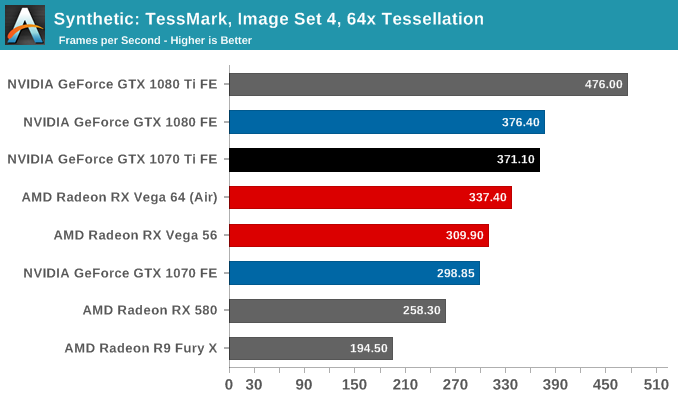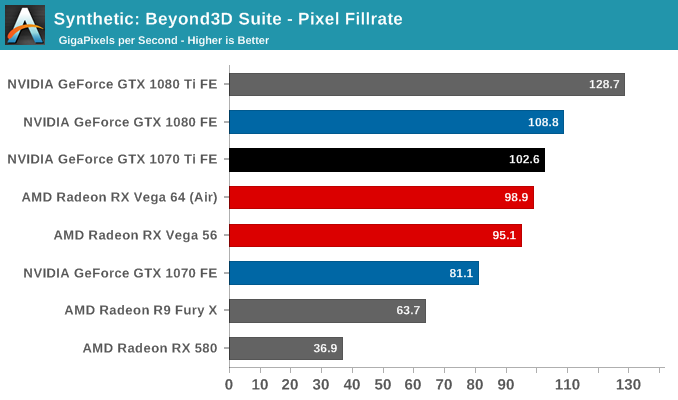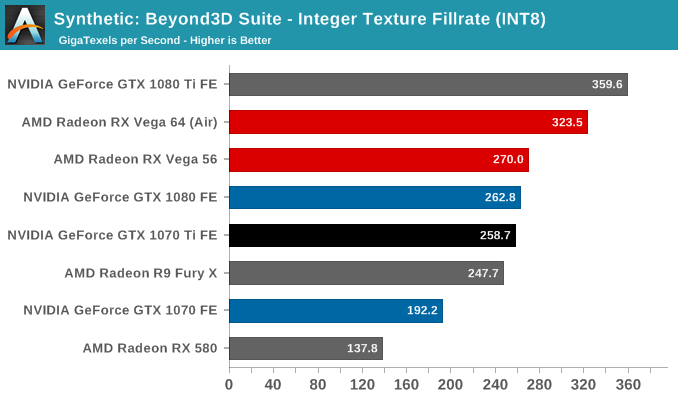The NVIDIA GeForce GTX 1070 Ti Founders Edition Review: GP104 Comes in Threes
by Nate Oh on November 2, 2017 9:00 AM EST- Posted in
- GPUs
- GeForce
- NVIDIA
- Pascal
- GTX 1070 Ti
Synthetics
Continuing onto our synthetic benchmarks, we should be able to see how the GTX 1070 Ti sits in between the GTX 1080 and 1070. These tests are more graphics focused than compute focused – especially the low-level tests – so it will be interesting to see how the GTX 1070 Ti compares to its fully-featured GP104 sibling, the GTX 1080, given how close they are so often in compute tests.

Starting off with tessellation performance, as NVIDIA's geometry performance is tied to the SMs, the GTX 1070 Ti benefits from having 3 more SMs enabled than the vanilla GTX 1070. This allows the new card to leapfrog both AMD Vega cards, coming in right behind the GTX 1080.

Switching gears, we have Futuremark's VRMark Orange benchmark. Essentially a synthetic gaming-type rendering workload with a focus on VR, this test pushes every part of a video card. Consequently, it also hits the weaker parts of the GTX 1070 Ti's configuration, particularly the lack of increased ROP throughput and memory bandwidth. As a result the GTX 1070 Ti still gains quite a bit over the GTX 1070, but it also trails the GTX 1080 by about 5%. Which, as it turns out, isn't too far removed from our general gaming benchmarks.
Finally, for looking at texel and pixel fillrate, we have the Beyond3D Test Suite. This test offers a slew of additional tests – many of which use behind the scenes or in our earlier architectural analysis – but for now we’ll stick to simple pixel and texel fillrates.

The pixel fillrate test is actually one of the more interesting results we have in today's review. While the GTX 1070 Ti doesn't get any more ROP resources on paper, pixel fillrates are a combination of both ROP (backend) and rasterizer (frontend) output. And in the case of NVIDIA's architecture, rasterization is not fully decoupled from the SMs; which is to say there's some scaling going on. And actually, this was more than I was expecting, with the GTX 1070 Ti coming very close to the GTX 1080 despite the memory bandwidth disadvantage. Not unlike tessellation performance, we see the new card leapfrog both AMD Vega cards here, pushing over 100 Gigapixels per second. In general pixel throughput is still going to be what best differentiates the GTX 1080 from the GTX 1070 Ti, but in this low-level test the two are closer than I would have expected.


Finally, for texture throughput, we're once again looking at a scenario tightly-coupled with the SM count. As a result the GTX 1070 Ti can deliver texture throughput rates very close to the GTX 1080.










78 Comments
View All Comments
Destoya - Thursday, November 2, 2017 - link
I feel like you're ignoring cards like the 1050ti/1050 in order to better match your narrative. Both of those require no power connectors (75W TDP) and will reach 1080p60 easily for modern AAA games and 144 FPS on esports titles. Yes, both companies are making power hungry monster cards to satisfy high-end demand that get a lot of headlines, but the chip designs scale down incredibly well. Performance for low/mid-end systems has never been as good as it is now.The_Assimilator - Friday, November 3, 2017 - link
Yes yes, everybody should still be using teletype terminals and typewriters. Or even better, go back to scratching lines into cave walls with rocks, because that uses no power and creates no heat.Lord of the Bored - Friday, November 3, 2017 - link
Actually, it does create heat. Thermodynamics is a harsh mistress.catavalon21 - Thursday, January 10, 2019 - link
+1sonny73n - Friday, November 3, 2017 - link
Graphic and resolution mean the world to them because they have no life.theuglyman0war - Saturday, November 4, 2017 - link
I thought it was because God gave us two eyes that can see? ( the same reason I get my prescription glasses updated every year. Fidelity. )Is Lo Fi hip again?
Ranger1065 - Friday, November 3, 2017 - link
You should be removed ASAP dear Ciccio.TheJian - Thursday, November 2, 2017 - link
Bought mine at $499 (EVGA FTW2). Don't feel gouged at all. If it's gouging, they'd still be on the shelf. I'm guessing they'll be out of stock shortly. If they priced like you want, they'd have quarterly reports like AMD.. ROFL. That should not be the goal for NV, but rather to price as high as the market will accept...PERIOD. It is actually their JOB to do this.Sounds like you need to upgrade your job so you can afford better toys ;) AMD has lost $8B in the last 2 decades and looks like they only made money for a single quarter this time. They are predicting a down Q yet again (how can you have a bad xmas Q?) and just after all these launches. YOU ARE PRICING YOUR STUFF TOO LOW AMD!
bill.rookard - Thursday, November 2, 2017 - link
Well, that's not entirely accurate, AMD has had some nominally profitable quarters before this - not to the level of Intel for sure, but saying they've lost money every single quarter in the past 20 years is patently untrue. There were many times 'in the past two decades' when they were actually eating Intel's lunch, so enough of the hyperbole.Yes, they've not had an easy time since then, and have been in the dumps especially with their previous generation designs which, well, sucked. (caveat, the 8 core 8000 series actually did well on video encoding but that wasn't nearly enough)
As for pricing stuff too low? They HAVE to right now. Their issue is one of market share, and with their previous generation u-arch it couldn't remotely compete with Intel, and that pitiful share is the result. Now that they have a u-arch which is close to parity from power and performance, just wait to see what happens in the notebook space where the Intel IGP is pitifully bad compared to the Mobile Vega. Besides - the main 'desktop' space is, while not dying, it is without a doubt somewhat stagnant as most people have a laptop which is powerful enough to get stuff done, while being portable.
That is the larger market, and one that the Ryzen APU's will have a much better chance at picking up share in.
webdoctors - Thursday, November 2, 2017 - link
You;re right, there was I guess maybe 40% quarters were profitable last 10 years:https://ycharts.com/companies/AMD/eps